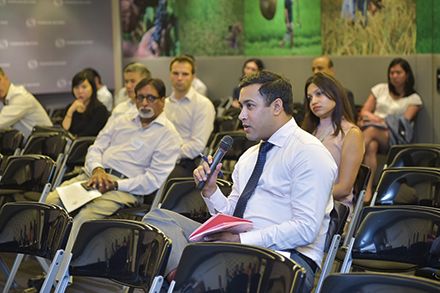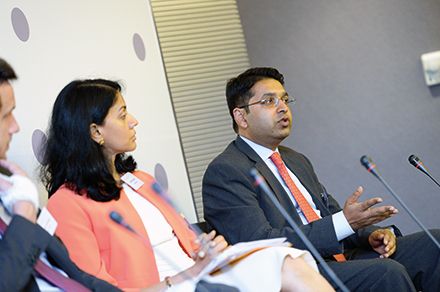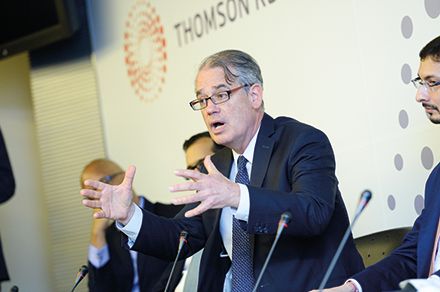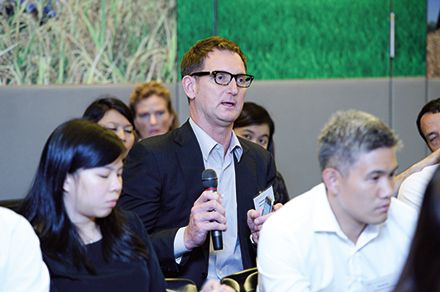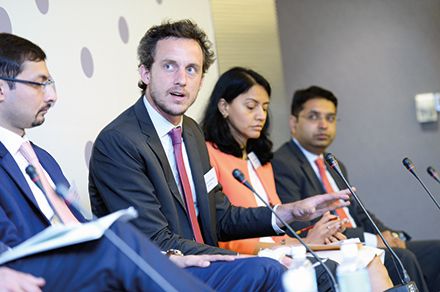IFR ASIA: Will we get to a point, do we think, that Green bonds actually offer a pricing benefit for an issuer? Who wants to tackle that one?
RAHUL SHETH, STANDARD CHARTERED: As you mentioned there is little to no pricing benefit today, and the reason being because the investors dominating the order book are 70%–80% conventional investors, who we cannot do without. And as an SRI investor I’m sort of comfortable thinking that I’m sitting side by side with the commercial investor and getting the same return. Unless the scale tilts towards a dominant green investor or an SRI investor base, personally I would see it as difficult to have a pricing benefit in this market. And, again, a huge pricing differential will be difficult to sustain, even if you have a very strong captive investor base, just because market efficiency may not allow that to exist.
IFR ASIA: Some of that speaks to secondary liquidity. If the green bond market ends up being bigger and trading more, then maybe that one will end up being tighter?
SABITA PRAKASH, ADM CAPITAL: On the other hand I would argue that if it’s a smaller deal, or if the market perceives it to be a little bit different from a plain vanilla bond, then it may have less liquidity and therefore have to trade at a discount. So it could work either way.
MADHUR AGARWAL, JP MORGAN: You see one challenge you have on the green bonds is sometimes because of the size they do not get into mainstream indices and therefore the liquidity in those bonds tends to be less. And therefore they don’t trade well. But if you’re doing a size of green bonds which can be included in a mainstream index, you have a bigger investment base available to you and to a degree the pricing should improve over time, because you have more investors trading. When you compare, for example, the Reg S market versus 144A, 144A gives you access to big US investors. And we have seen over time the pricing improves due to access to larger investor pool. The same benefit should be available to green bonds if you have a bigger set of investors who are accessing your bonds.
SABITA PRAKASH, ADM CAPITAL: Are these bonds going to form part of the indices if they are structured as green, because a number of the indices go only for vanilla bonds?
MADHUR AGARWAL, JP MORGAN: You see if it’s green only because of the use of proceeds and other features are similar to vanilla bonds then it does get into the index. The Exim India bond was included in the index. So you would get the benefit of better pricing, over time. It’s not that you would be immediately able to see it trading tighter in secondary, but maybe over a period of time.
MUSHTAQ KAPASI, ICMA: Has there actually been a measurable difference in the secondary liquidity of Green bonds compared to vanilla bonds over the last few years?
PHILIPPE AHOUA, IFC: Not in ours. They both trade exactly the same way because we do benchmarks at both.
RAHUL SHETH, STANDARD CHARTERED: Funnily enough, I just checked this before I came in. You had Morgan Stanley, ABN AMRO and Bank of America Merrill Lynch – three Green bonds that just priced earlier this month or late last month, and all of them were trading at 5bp–10bp or 10bp–15bp inside the conventional bonds at very similar maturities. Now five basis points tomorrow might be zero the day after. It might be minus three the day after that. So it’s very difficult to base that as a definite advantage that will always exist. But it’s interesting to see that some of these bonds are actually trading tighter. And 15bp I would say is a reasonably good differential.
SEAN KIDNEY, CLIMATE BONDS INITIATIVE: The other signal we saw was when there was a crisis in the Korean peninsula, all the Kexim bonds went down the chute, except the Green bonds. What we find happens is that investors if they’re going to dump bonds, dump the ones that haven’t got the bonus feature first. Our view is that when we get up to a certain scale, we would expect to see enough evidence of secondary market benefit that that will have an impact on primary pricing. Now, I’m not saying that will be a big benefit. That will come from government action, tax credits, credit enhancement and so on.
QUESTION: I have a question about the investor base. Sabita, are you seeing funds or investors who are interested solely in the green space? Let’s say you’re not finding the right pricing in the traditional high-yield market, are there other investors you can go to simply focusing on the fact that you are a green company?
SABITA PRAKASH, ADM CAPITAL: Absolutely yes. A number of these green companies are not necessarily just green. They are regular companies, who are making a good return and are just looking to raise financing to grow their business. For instance, we are not in the bond market. ADM Capital invests in private credit. In other words, we give loans with collateral, secured loans. We have looked at companies who are maybe too small to go to the bond market. Again, it’s that question of scale. It doesn’t make sense for them to raise US$50m from a bond, rather they would come to companies like ours, and we have invested in many of them. If they fulfil these parameters that we’re talking about – particularly the ESG, the environmental and social governance parameters – it’s one way of defining “green”.
RAHUL SHETH, STANDARD CHARTERED: I think slightly differently, and I’m talking from one of the cases that we actually had for a high-yield / unrated issuer who was having a slightly difficult time in the public bond market. They were in a green business, and they tried to venture into this green market. Eventually what we realised is, a lot of the green funds would not invest in anything less than Triple A, or needed very highly rated issuers. Many of them are pension funds, so they are not the accounts who will be looking at this credit. From the other side you have the conventional investors who have a green portfolio, who are going to charge you some liquidity premium for a private placement. It’s very difficult to hit that middle ground for a high-yield issuer, at least from this experience.
SABITA PRAKASH, ADM CAPITAL: I would agree that the scale is still small. Asia is still young as far as this market is concerned. But increasingly there are funds like ourselves who are looking at this space to invest, or even to raise funds that invest in green assets. You do have these kinds of funds in Europe and in the US, but it’s very limited in Asia. So it will take time, but I definitely see the signs.
MADHUR AGARWAL, JP MORGAN: One thing which would help in some of these projects is multilateral agencies providing partial credit enhancement for these companies. That definitely improves the marketability of these bonds. Some of these green investors do not want to do their own due diligence, and if you have a multilateral who has done that and transferred some of the risk, it definitely helps.
SEAN KIDNEY, CLIMATE BONDS INITIATIVE: That’s a cue for Philippe isn’t it?
PHILIPPE AHOUA, IFC: I don’t need to do any of my own marketing here! You know, one of the things we’ve been asked in a lot of these panels is why the Green bond market hasn’t developed that much in Asia. When you think about Asia in general the use of bond markets for corporates is relatively thin compared to other parts of the world. I mean it’s still very heavily a bank lending market in general. So you still have that sort of barrier as well.
We’ve actually been more successful in supporting Green bond issuance from corporates in places like Latin America, Africa to a certain extent, than we have in Asia. Because in Asia it’s really difficult to get corporates to move away from bank financing in places like China, Thailand and the Philippines, for example.
MUSHTAQ KAPASI, ICMA: I think that’s poised to change very fast especially in China. ICMA had its annual conference a couple of weeks ago in Europe where NAFMII, which is the Chinese self-regulatory organisation under PBOC, listed developing the corporate bond market as one of their top policy priorities. When the PBOC says it’s a top priority, it’s going to happen.
SEAN KIDNEY, CLIMATE BONDS INITIATIVE: If the 13th Five-year Plan has as big a section on green finance as we’ve been told it’s going to have, if the PBOC guidelines come out as we expect, if NAFMII and the other regulators do what they say they’re going to do, and then if the government starts ordering people to issue to drive liquidity, you’re going to get a very big market very quickly. Own view is China will be the world’s largest Green bond market in 2018, by far. Now that’s going to have a regional impact.
The opportunities are going to be really, really substantial – albeit from a very small base. To begin with the opportunities are renminbi issuance in London, rupee issuance offshore and so on.
IFR ASIA: How do we think the China market will start? Will it be the banks that issue first?
SEAN KIDNEY, CLIMATE BONDS INITIATIVE: Yes, there’s a bunch of banks that are lining up to issue. You’ve got reputational pressures already building, and people are starting to explore it.
PHILIPPE AHOUA, IFC: We’re very keen to go back into the domestic Chinese market in whatever format, whether it’s green, non-green, blue, or whatever you call it. But the domestic market is not really conducive to a specific universe of issuers. There’s still a lot of things that they need to do. But, you know, we supported Yes Bank in one of their issuances…
SEAN KIDNEY, CLIMATE BONDS INITIATIVE: You took a third.
PHILIPPE AHOUA, IFC: We took a third. We’ve got a toolkit of ways to support green capital market issuances by corporates in the region. This is actually very high on our agenda.
QUESTION: You mentioned earlier how green do you need to be to do a green bond, and obviously that has potential risks for investors. From your standpoint, what would you like to see as a minimum template for the criteria?
SEAN KIDNEY, CLIMATE BONDS INITIATIVE: You can best describe this as helping the rapid transition to a low-carbon and environmentally sustainable economy. One of the things we’re trying to do to support the market is to take the seven broad areas in the Green bond principles and turn those into usable definitions for the market. And out of those clear criteria, someone like Vigeo then is able to do an assessment against public standards.
It needs to be rooted in what climate scientists are telling us are appropriate transition pathways. That’s not a simple task. I’ll just give you one anecdote of the kinds of things you come across when you start looking into this. In a number of development banks – not the IFC – geothermal power is included as a green investment. Well, actually, we found out when we talked to the IFC experts and a few others, a lot of geothermal isn’t green. In Turkey, when you drill down through calcium, geothermal has a high greenhouse gas output. So if ADM’s colleagues had bought some Green bonds with geothermal in Turkey, they’d be out on a limb one day when some green group wised up to this. So that’s a classic example, where you need to have the science input early on to protect investors.
LUDOVIC D’OTREPPE, VIGEO: I like the keywords: simplicity, transparency. That’s what’s needed if you want to build a Green bond market, and in other regions that is already well established. The positive impact of a project has to also take into account the way the issuer will actually manage that project, and there are plenty of examples of controversy in which companies had raised bonds in the markets. For example, for a huge hydropower plant in South America, you might think the nature of the project is a no-brainer. But let’s actually look at how you will build this huge infrastructure, in an area where there is basically nothing except local populations enjoying a certain way of living. So you have to consider the full scope of the issuer’s responsibility to make sure, as Sean has explained, that there are no bad surprises three or five years after you put your money into a specific bond. So what we try to guarantee to the market is simplicity and transparency.
PHILIPPE AHOUA, IFC: I just want to add one point. From the development bank perspective, whether this is a green investment or not, we go through that whole due diligence process, looking at displacements of indigenous populations and you name it. We’ve done this for as long as we have existed. So for us, moving to a green sort of disclosure requirement process was very simple. That may not be the case for any corporation, especially if you’re going to go into green capital markets financing just to diversify your investor base. If at the end, the whole cost exercise is astronomical, it’s going to be quite difficult.
RAHUL SHETH, STANDARD CHARTERED: In terms of the disclosure requirements for a typical corporate bond, it’s usually a few paragraphs in the use of proceeds section. It could be describing an overarching framework of what the projects would look like in terms of where this money would be invested, and then there’s some disclosure on how the proceeds from the bonds go to an account or a sub-account and how they are tracked to the final project. And then you have some kind of periodic disclosure where you’ve got to have the auditor checking that the proceeds have been tracked properly.
Sometimes, you will have more frequent disclosure on a website, where they give you details on what emissions targets have been reached, how much has been invested, and where the unused proceeds have been parked. If it’s not for refinancing it could be that the funds are invested in marketable securities before they are deployed. All those sorts of things need to come out either on the website or in some kind of disclosure to the investors.
QUESTION: I was in some discussions with IFC, in fact, in Sri Lanka, where there was some debate about the merits of an electric rail project because of the way the power is generated. It actually looks complicated, but I go back to the point about the scientists and that the definition of green is a moving target itself.
SEAN KIDNEY, CLIMATE BONDS INITIATIVE: Well, it is a moving target and it’s important when you develop standards that you retain a dynamic approach. We’re learning all the time. But in a rapid transition model we can’t wait for Sri Lanka’s grid to go green before we build the right infrastructure for 2050. We have to do that work in parallel.
We’ve got a climate science committee to advise us on frameworks. And then you test that out on bankers to see whether this is actually going to fly in the bond market. And if you can get through those twp hoops, you’ve got something which can help grow a green bond market.
LUDOVIC D’OTREPPE, VIGEO: And to go further on that we have a study on the question you have raised –how green is green? The point you raised is excellent, just having electric vehicles, for example, is not helpful if you don’t look at the whole process. But today, we have now the tools, the methodology to measure, assess and compare different projects and provide clear indications to the investor base. So at least they know the entire footprint of a project.
RAHUL SHETH, STANDARD CHARTERED: In fact I believe some of the verifiers a actually have a ‘shades of green’ sort of opinion, where it’s a dark green, medium green or a light green. The light green is basically where the benefit is short-lived, and there is no sort of strategic shift to cut out fossil fuels. And the dark green is closer to meeting the 2050 objectives.
LUDOVIC D’OTREPPE, VIGEO: And believe it or not the study is called, ‘Fifty Shades of Green’.
QUESTION: Just a question on this principle of additionality. What if an issuer is doing something that is green, but it’s just meeting state regulations, and would have happened anyway without Green bonds, would that count?
SEAN KIDNEY, CLIMATE BONDS INITIATIVE: Of course. There are many reasons why we do things. What we’re trying to do is to maximise the drivers for change. We want to amplify everything that’s going on.
But the second point is this idea of additionality, which is the approach in the carbon markets. This comes down to the role of bonds. If the bonds are primarily a rfinancing tool then focusing them only on new projects is not going to be particularly useful. The most useful thing we can do is to create a large liquid re-investing market to embolden equity and bank lending. This is fundamentally different from carbon markets and fundamentally different from additionality as we understand in other areas. And we need to understand that.
SABITA PRAKASH, ADM CAPITAL: I would add to that by saying that as far as commercial investors are concerned, they want simple, they want scale and they want something that they can invest in. So for volume and for scale you do need the simple stuff, and refinancings through bonds the way we’re discussing green bonds makes a lot of sense. But, as you rightly said, there is a small little niche available for additionality, like, for example, social impact bonds, which involve a certain amount of structuring and therefore become a little more complicated, and will never be invested in by the mainstream investors – at least not at first. But maybe an SRI investor, a socially responsible investor, is interested in these kinds of structures that sort of conveys that additionality that you’re talking about and takes the entire green principles forward and accomplishes more than just the standard.
QUESTION: Thank you very much for your insights so far. You’ve mentioned that the Asian market has very much driven top-down and that China will be unveiling some draft regulations. Can you share some thoughts on whether other emerging market governments have or are likely to share some regulations too? And secondly, do you think there’s a risk of policy unwind or policy reversal if political policies change, if the market is being driven top-down. Thanks.
MUSHTAQ KAPASI, ICMA: Those are two very good questions. I’m not sure if I can answer them fully. In terms of the top-down approaches from other Asian countries I’m really only aware of China and to some extent India in a sort of different way, in terms of directly proclaiming publically their desire to develop a green finance market. If you look at other countries in Asia, even a country like Malaysia has a big push for some socially responsible investments that’s closely allied to Shariah finance. Australia might be an exception as well.
Now, on your second point, policy reversal actually opens up a big can of worms. I think this is a risk in terms of certain types of policies such as tax incentives. Other kinds of incentives, such as capital benefits, those are a little bit harder to reverse. But in my personal opinion I think China realises from the top down that the environment has to be dealt with, and there’s a long-term commitment to a positive environmental policy which will then trickle down to green finance.
MADHUR AGARWAL, JP MORGAN: On the India point, the push is more on the renewable energy front. The government is not really getting involved in guidelines on green financing. They want to push renewable energy because coal is getting costlier, and it’s not environmentally friendly. And green financing is being encouraged as one of the additional means of financing the renewable projects. The government is dependent on public sector banks for much of that financing, and to that extent any new regular financing helps. Second there is no incentive or tax benefits for the green financing and therefore the risk of reversal is not really there.
IFR ASIA: Is that the same in more developed markets? You mentioned the tax credit in the US for instance.
SEAN KIDNEY, CLIMATE BONDS INITIATIVE: There are a bunch of green specific incentives floating around, including the green property one I mentioned before. We’re beginning to see governments look at how they can ride on that back of that and turbo-charge that with further incentives. So the UK government has been considering for some time green ISAs or green retail bond tax credits, for example. You may see, if Hilary Clinton gets elected, more tax credit schemes in the US or at least a shifting away from oil and gas tax credits. Brazil is looking at a whole bunch of these things as well. In a way we’re pushing an open door, because we’ve proven demand through the markets, it’s amazing how politicians feel much more comfortable to act when they can see something already happening.
RAHUL SHETH, STANDARD CHARTERED: In terms of issuing tax-free bonds, that’s pretty much dominated by the local currency market. So in India I can do a tax-free green bond in the INR market, but I can’t really market that to global investors where they don’t have the same tax benefit. So sometimes these benefits may localise the bond.
QUESTION: I just wanted to dig a little deeper into your expertise on China. They state in the document there’s limited public funds available, so there’s a big gap to the kind of investment that is required. How much of that gap can Green bonds actually fill? And why are they choosing an industrial bank as the first issuer rather than the big policy banks?
RAHUL SHETH, STANDARD CHARTERED: Maybe I’ll take the first question and then Sean can go ahead. Again, there’s definitely a gap in China and India in terms of the amount of investments that they require. Also, the report really talked about a 14-point agenda, and green bonds are just one of them. You’ve got green IPOs, you’ve got green insurance, you’ve got green securitisation. They have borrowed this policy, again, from the West, where the cost of insurance for a polluter is higher.
So, again, some of the green financing already exists in some format. It’s just about standardising that to an extent. These targets may or may not be met eventually, but that’s at least heading in the right direction in terms of setting out a policy. And if China takes the lead in institutionalising a few of these things that can really create a market. Once you have a Big Four Chinese bank issuing, you’ll have a number of issuances that will follow.
Just to give you an example, that if you look at the development of the overseas Basel III Hybrid Tier 1 market in China, you had Bank of China do a bond last year, then ICBC followed and then BoCom and CCB are to follow in this sort of domino effect. Clearly they could have and have done a lot of this financing locally, but they went to the overseas market for a deeper and diversified investor base. So I think it’s a step in the right direction to get the banks to start issuing and then take it from there.
SEAN KIDNEY, CLIMATE BONDS INITIATIVE: A simple one first, why Industrial Bank? They’re keen and they have a surprisingly large green finance portfolio. They actually issued a US$30m green securitisation last October already, but they weren’t allowed to call it green by the PBOC. So we carried it in our unlabelled market, because we were not allowed to carry it in our labelled market yet. They’ve been champing at the bit…
PHILIPPE AHOUA, IFC: We help set up that activity with the support of the Chinese Government for a number of different banks, and the Industrial Bank was actually one of the leading banks in terms of developing a green portfolio.
SEAN KIDNEY, CLIMATE BONDS INITIATIVE: There we go. Having said that, China Development Bank says that a quarter to a third of all their bonds will be Green bonds once the regulations are in place. That’s volume. I’ve got two meetings with policy banks this week, later this week in Beijing.
But your bigger point is how much is this going to help? Well, clearly it’s not going to solve the problem. We’re talking about a global re-industrialisation between 2050. Our objective must be to phase out all fossil fuels by 2050. I think we have a damn good shot at doing that, because the extraordinary progress we’re making in reducing costs of things like solar. So we actually have now the technical opportunity to make the transition. A lot of the things now are government barriers, like Japan refusing to push Tepco to buy energy from roof-top solar panels, little things like that that are all over the place.
This change requires government planning. This city of Singapore is not green enough despite being very proud of its platinum-rated buildings. It has to dramatically reduce its footprint between now and 2050, and that will require a government push. It’s not going to happen organically. What we’re trying to do is embolden governments to understand that the private sector will step up and pay for this sort of stuff if the deal is created in the right sort of way.
Crudely speaking I would have thought that we’re expecting to see US$300bn of issuance in 2018. I think China is going to be about US$80bn. And I think that will come quite quickly from the development banks involved. In 2020 our objective – not so much projection – is US$1trn of issuance. That will be a material contribution. It will have a pull-through effect for other sorts of financing, and it will help to change the narrative from a burdensome carbon narrative that we’ve had for the last 20 years to a positive narrative around green infrastructure stimulus.
PHILIPPE AHOUA, IFC: I have a follow-up question. In China specifically do you see any will from the government to standardise disclosures around Green bond issuance?
SEAN KIDNEY, CLIMATE BONDS INITIATIVE: Yes, there is. The big achievement of this work that we’ve been doing with Ma Jun, the chief economist of People’s Bank of China, is now showing up in the forming of a Green Finance Committee that involves the chairman or CEO of every regulator. So for the first time in China’s recent financial market history we actually have a proper coordination mechanism. Two thirds of all the institutional investors on China are represented on that committee. That’s never happened before.
I think we’ve got a shot at making this work now, but it’s not going to be there on day one. In this coming year is it will be a supertanker that’s started moving in the right direction, and the important this is just trying to get it started. Once it is, it should be easier to shift the direction, but we’ve still got to work to steer it the right way.
QUESTION: Is there any need for a market maker in this particular area? And also, is there a need for more multilateral involvement, but from Asia? Say is there a role for the AIIB for instance?
MADHUR AGARWAL, JP MORGAN: On the market maker side, I think the green bonds do trade as well as the normal bonds. The banks do make markets in these bonds. On the other point in terms of local Asian issuers I think my personal view is that you will see more issuances from policy banks – we have already seen Korea Exim, we have seen India Exim doing it. So you will see more of the Chinese policy banks accessing this market, and you may not need an Asian IFC-like issuer to develop this market. It should come from the commercial and public sector banks.
RAHUL SHETH, STANDARD CHARTERED: The last one again was ADB – they just did a green bond. But let’s take a step back. The product is a simple DCM product. It’s a bond at the end of the day, so you have your DCM banker who does a normal vanilla issuance for his client, effectively pitching just another product with the same fundamentals. There’s no change in credit. You still need the same documentation with a slight difference that I talked about earlier – 95% of it is the same. The additional stream is a technical work stream where guys like Vigeo come in. At the end of the day, it’s just adding another layer on top of a vanilla issuance.
SEAN KIDNEY, CLIMATE BONDS INITIATIVE: On the AIIB, I spoke to someone who had come from the planning meeting and I understand China has actually built in green criteria into how the bank is going to work. We’re hopeful that it will be a significant part of the criteria. We’re also modestly hopeful that their inaugural bond will be a Green bond.
IFR ASIA: You know their motto is ‘Lean, clean and green’. That’s up on the website.
SEAN KIDNEY, CLIMATE BONDS INITIATIVE: There we go.
IFR ASIA: Ladies and gentlemen, thank you all very much for your insight.
To view all special report articles please click here and to see the digital version of this report please click here .
To purchase printed copies or a PDF of this report, please email gloria.balbastro@thomsonreuters.com.
